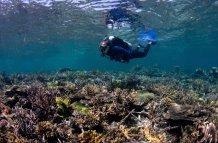In Indonesia, thousands of square meters of coral are being grown on formerly damaged reefs, but earlier, it was uncertain if these new corals would recover the complete reef ecosystem.
 A restored reef, 3 years after installing Reef Stars (Image Credit The Ocean Agency).
A restored reef, 3 years after installing Reef Stars (Image Credit The Ocean Agency).
In a recent study, guided by scientists from the University of Exeter and the University of Bristol, a healthy, diverse soundscape has been discovered on the restored reefs.
These sounds — a number of which have never been taped before — can be used together with visual observations to observe these essential ecosystems.
"Restoration projects can be successful at growing coral, but that’s only part of the ecosystem," said lead author Dr. Tim Lamont, of the University of Exeter and the Mars Coral Reef Restoration Project, which is involved in restoring the reefs in central Indonesia.
"This study provides exciting evidence that restoration really works for the other reef creatures too — by listening to the reefs, we’ve documented the return of a diverse range of animals."
Some of the sounds we recorded are really bizarre, and new to us as scientists. We have a lot still to learn about what they all mean and the animals that are making them. But for now, it’s amazing to be able to hear the ecosystem come back to life.
Steve Simpson, Professor, University of Bristol
The soundscapes of the reestablished reefs are not matching those of current healthy reefs — but the variety of sounds is similar, signifying a healthy and operational ecosystem.
There were considerably more fish sounds taped on both restored and healthy reefs than on ruined reefs.
This study utilized acoustic soundtracks captured in 2018 and 2019 as part of the tracking program for the Mars Coral Reef Restoration Project.
The results are affirmative of the project's methodology, in which hexagonal metal frames known as ‘Reef Stars’ are seeded with coral and placed over a large area. The Reef Stars steady loose rubble and renew rapid coral growth, resulting in the restoration of the wider ecosystem.
Mochyudho Prasetya, of the Mars Coral Reef Restoration Project, stated: "We have been restoring and monitoring these reefs here in Indonesia for many years. Now it is amazing to see more and more evidence that our work is helping the reefs come back to life."
When the soundscape comes back like this, the reef has a better chance of becoming self-sustaining because those sounds attract more animals that maintain and diversify reef populations.
Professor David Smith, Chief Marine Scientist, Mars Incorporated
When asked about the numerous dangers facing coral reefs, including water pollution and climate change, Dr. Lamont explained: "If we don't address these wider problems, conditions for reefs will get more and more hostile, and eventually restoration will become impossible.
"Our study shows that reef restoration can really work, but it's only part of a solution that must also include rapid action on climate change and other threats to reefs worldwide."
The research was partly financed by the Natural Environment Research Council and the Swiss National Science Foundation.
The research findings have been published recently in the Journal of Applied Ecology.
Journal Reference:
Lamont, T.A.C., et al. (2021) The sound of recovery: coral reef restoration success is detectable in the soundscape. Journal of Applied Ecology. doi.org/10.1111/1365-2664.14089.